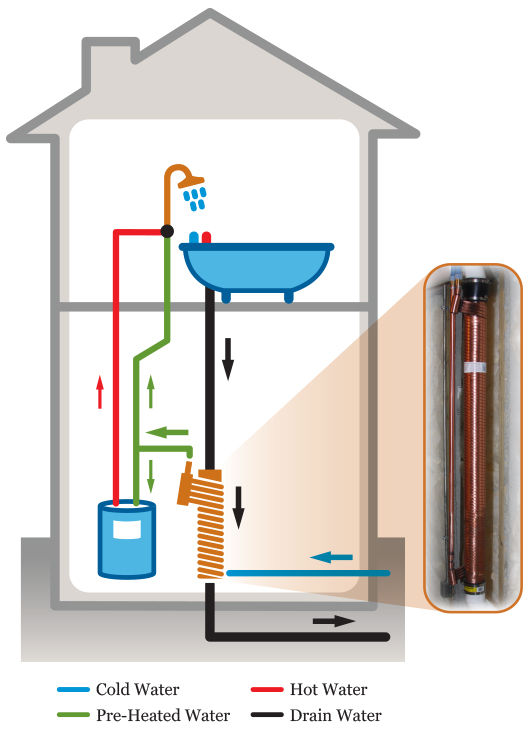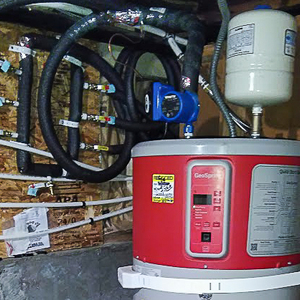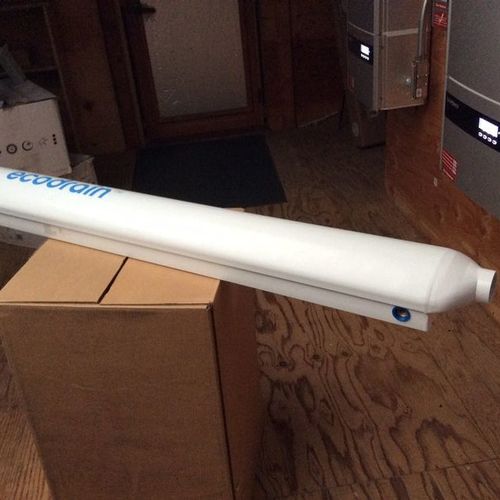
Image Credit: Renewability Energy Inc.
Ontario has become the first province or state in North America to recognize drain-water heat recovery (DWHR) as part of its building energy code. Provincial builders will now be able to use DWHR to meet energy-savings requirements in the Ontario building code, and the change also should prove a boost for manufacturers.
Drain-water heat recovery is a way of extracting heat from hot water that’s dumped down a drain — from a shower, for example. The units, which cost an average of $600 to $800, according to one Canadian manufacturer, consist of a copper heat exchanger that replaces part of a conventional drain line. Copper tubing wrapped around the outside of the pipe carries incoming water and allows it to pick up the heat of the drain water that’s exiting the house.
According to RenewABILITY Energy Inc., manufacturer of the Power-Pipe, adding DWHR will lower total energy costs for new homes by about 10% and lower water heating costs by at least 20%.
The company said the change in Ontario sets the stage for similar moves in other parts of Canada and the United States. The technology has already been adopted in France and the United Kingdom and is expected to be approved in Sweden as well, the company said.
Weekly Newsletter
Get building science and energy efficiency advice, plus special offers, in your inbox.















10 Comments
Definitely works- most cost-effective at higher energy prices
When I installed one in my own home a handful of years back residential-retail natural gas was a buck fifty/therm (delivered) and looking to climb, but now they're bouncing around in the buck-a-therm range. My reasons for installing one had as much to do with boosting showering performance on my combi-heater setup during simultaneous calls for space heating than mere fuel cost savings, and I'm happy to have both.
Several states will subsidize them for folks heating hot water with electricity (IIRC NY, CT, OR, VT, MN, WI, all have either statewide or local utility rebate type subsidies available, maybe some others), but not so much for those heating water by other means. But showering families heating hot water with resistance electricity, oil, or propane would see payback in relatively short years at recent fuel pricing.
In my own state of MA there is no subsidy, and only Renewbility's lineup is currently listed on the MA Accepted Plumbing Products list (though others could clearly qualify, or would be allowed on a variance at the local level).
http://license.reg.state.ma.us/pubLic/pl_products/pb_search.asp?type=P&manufacturer=Renewability+Energy+Inc.&model=&product=&description=&psize=50
The US distributor for Renewability is EFI (headquartered in MA), and they're pretty liberal about allowing individuals to open accounts with them, bringing the component cost down substantially from the brick & mortar or direct from manufacturer list-prices on DWHR:
http://www.witrendhome.com/media/watters-efi-powerpipe.pdf
Natural Resources Canada maintains a tested-performance list to be able to compare apples to apples amongst models & vendors:
http://oee.nrcan.gc.ca/residential/personal/retrofit/13302
It should be noted that they only work during simultaneous drain & hot-water flows, so tub-bathers aren't going to see a measurable improvement on water heating efficiency with them.
For hot water gluttons with 6 gushing side-sprays on the showers it's far cheaper than buying multiple commercial tankless HW heaters to handle the sustained flows and cuts the fuel consumption in half. (But nobody reading a green building blog is likely to be building one of those, eh? ;-) )
G'dang!
There I went and did it, writing a longer response post than the original blog article. :-)
Hot water gluttons
"For hot water gluttons with 6 gushing side-sprays on the showers it's far cheaper than buying multiple commercial tankless HW heaters to handle the sustained flows and cuts the fuel consumption in half. (But nobody reading a green building blog is likely to be building one of those, eh? ;-) )"
You'd be suprised about that ...
i am pretty found of very long very hot shower,
and the first floor shower i installed already has 4 outlets, and i regularly use 3 of them simultaneously ( it is my stress relief time .. )
and my main bathroom ( soon to be done ) will have 6 outlets using Kohler DTV valves....
but that all brings me to " DAMN do i need to work on my hot water setup "
right now i am spending more than 1000$ /year on heating water
BTW...
did some research a
BTW...
did some research a few days ago...
seems like many chinese manufacturer already provide with split HP water heater working down to -20C or so ..providing COP of 2 to 4 .
Fujitsu also seems to have a few models and units out in some eastern europe countries
with higher COP ...
I inquired with 2 chinese manufacturer that "looked" better than usual chinese products,
and i was quoted in the 1000-2000$ per kit ( 300liter insulated tank + exterior heat pump and all required parts )
When are we going to get the goodies ??
So, Jin...
... do you have your drainwater heat recovery system installed yet?
No matter how you're heating hot water, a DWHR is going to pay off in gusher-showers like that, and if you have a tank, you'll double (or more) the available showering time. (Which is why I set the time-out on the bathroom occupancy sensor light switch to about 10 minutes, otherwise my kid would still be in the shower. :-) )
Dana: i am a bit shy to
Dana: i am a bit shy to admit ..
i have 4 electrical water heater tanks ( 60gals ) installed in pairs
we will have alot of visit in the future ( family all over the place ) and need to be able to 'serve" many showers /baths in a row and since the standby heat is only wated during summer ..
i haven't installed a recovery unit yet , i was unaware of the existence of such device a few years ago..
in fact , i was unaware of many things about "efficiency" and " green building " only a few years ago
i am still considering what i will do for my house in the near future ..
may be looking to get a chinese heat pump and remove 2 of the tanks,
the 2 remaining ones would be feed by a preheated tank run by the HP
not too sure how this would turn up the efficiency
the recovery system on drain would be a nice thing to add here for long shower
i am considering it ..may DIY one ..i'll see how it goes
my water system is already much complexe, and i still have to figure out how i will be re-using
my current geo loop and water tank system with solar thermal
or not use it at all and invest more in PV ...
the only thing i am sure of, is that i will not make the same mistakes again
in my future projects ! :)
Showerhead
Hi Dana: When I swapped out all the conventional 2.5 GPM showerheads in my house for Niagara Earth 1.25 GPM models (approx $7 each), I was pleasantly surprised to discover no difference in shower efficacy. The combination of a Niagara 1.25 showerhead plus a Power Pipe would save approx 75% in energy vs. the base case; enough perhaps to allow you to consider raising the occupancy sensor to 11 minutes if desirable?
My opinion:
OMG, the world has truly lost it's mind!
And this "technology" proves it!
I've been a residential contractor for over 40 YEARS.
I also have a degree in Chemistry (think thermodynamics).
What you're describing for a typical single story slab on grade house in So Cal is RIDICULOUS.
Maybe in Alaska with a large family, but not an average SoCal home.
1)My gas bill for just my (tankless) water heater(s) is around $30/mo. (I've measured it.)
This doesn't include the gas furnaces and clothes dryer.
Assuming my (tankless) water heater is 80% efficient with another 5% pipe losses, thats $22.50 worth of gas/mo, the rest being wasted heat not subject to recovery by a drain water device.
Now assume that 80% of that hot water will go down drain lines connected to recovery devices (ie, not the bath sinks, toilets or washing machine). Now we're talking $18 worth of gas spent heating the water attached to the devices.
2) If 57% of the heat can be extracted from the drain water
(see: https://www.supplyhouse.com/ThermoDrain-TDH3620B-DR-PEX-57-2-Efficiency-3-x-62-x-3-4-TDH3620B-Hot-Water-Heater-Booster-with-2-Drain-Couplings-2-PEX-Fittings?gclid=EAIaIQobChMI0JKe1fzM8gIVURh9Ch2tCQ-DEAQYAiABEgIxZ_D_BwE )
now we are talking about saving $ 10.26 worth of gas/mo.
AND
you have these devices at EVERY point of hot water entering the drain lines via a tub, shower, or kitchen sink (ie, not bath sinks and washing machine drains), such that a TYPICAL 3 bedroom, 2 bath house would need 3 such devices.
AND
ALL the pipes (both drain and pressurized) and the tub and shower floors are VERY well insulated and of a short distance so that we can assume a small 5% heat loss,
Now 'we're talking $9.75 worth of gas/month.
$9.75.
Three (3) devices will set you back $1500-$2000+.
The under-slab plumbing, connecting the devices and pressure testing before drywall another $2000 in labor and materials, and you've got..... WAIT FOR IT....
$4000 cost to save $9.75/mo.
This will require, IN THEORY, a 35 YEAR (4000/9.75 = 410 months) payback period!!!
Of course, it will NEVER payback. WHY?
All you need is ONE (1) underslab leak or device failure and you can start adding THOUSANDS to the cost of the system and DECADES to the payback period.
And don't get me started about running a snake with cutters down a thin wall (soft) copper line.
Or using caustic drain cleaners.
And with new housing already being SO unaffordable, this is not green, it is a boondoggle.
Respectfully submitted,
William Best, BA, MS, JD
William Best,
You're right that the installation of a drainwater heat recovery device is unlikely to have a quick payback period for a single-family home in Southern California. Payback is higher when (a) energy costs are high, (b) hot water use is high (which is why these devices make sense in multifamily buildings and laundromats), and (c) climate is cold (and incoming water temperatures are low). Note that this article is about Ontario, not Southern California.
Researchers have measured hot water energy savings attributable to these devices in the range of 15% to 22%. In your hypothetical case ($30 per month for hot water), savings would be in the range of $4.50 to $6.60 per month -- so your estimate of a monthly savings of $9.75 is a little high.
More information here: "Drainwater Heat Recovery Can Lower Your HERS Score."
Hi Martin,
Thanks for the feedback.
Again, my opinion.
As a contractor, I deal with Title 24 here in California in every project, and these devices are already in the energy saving basket of tools, although not yet required. We're seeing the same thing here for balancing fans. A $1000 fan, more ducting, difficult installs in certain construction instead of a $25 bath fan which is handling a measly 50 cfm.
I think where there might be value in drain heat recovery is where 1) hot water usage and energy costs are high, 2) plumbing costs can be kept down(short. easy runs without costly maintenance issues) and 3) only 1 device is needed.
Difference in incoming water temperature is probably not that big of a factor. Even if you have 40 degree (yearly average) incoming water temperature (freezing is 32 degrees) vrs say 55 degrees, at 57% efficiency, that's only a 8.5 degree difference.
If the optimal shower temperature is 112 degrees (see: https://www.wsj.com/articles/burning-question-what-is-the-best-water-temperature-for-your-bath-or-shower-1451931152#:~:text=The%20optimal%20temperature%20for%20shower,Clinic%20dermatologist%20Melissa%20Piliang%20says.&text=Few%20things%20feel%20better%20than%20a%20hot%20soak%20on%20a%20cold%20day),
the extra "benefit" by having cold incoming water pre-heated is an additional 13% added to that $9.75, or around a $1/mo. for a (non-high volume hot water) user like myself.
Personally, I am all about green, but cost has to be a factor in the equation also.
As someone who also repairs and maintains houses and apartments, when you tell me about such a device in a single story on grade house, what comes to my mind is an expensive maintenance nightmare due impossible to reach installation locations (eg, under a concreted shower floor or 300# tiled-in bathtub plus many feet of under-slab copper. As the system ages or with bad workmanship, it becomes a game of whack a mole.)
But you won't know about the leak until you get a $1000 water bill or your hardwood floor starts buckling. The % likelihood of such a bill should, by all rights, be added to the real cost of such systems.
Translation: leak detection workers, ripping up your hardwood floor, potentially under cabinets, and a jackhammer.
Just for starters.
There are LOTS of issues here, like using 1/2 copper piping.
In copper, if ANY of the to-be-heated water for an average house is restricted at ANY point to less than the combined area of 3/4" pipe (including in the device itself), you will undoubtedly exceed the acceptable water velocities for the pipe, which, besides being noisy, will cause early pipe failure and an expensive repair bill.
Log in or create an account to post a comment.
Sign up Log in